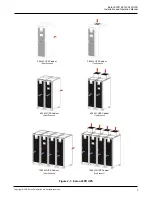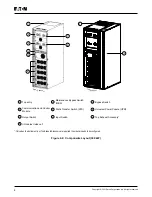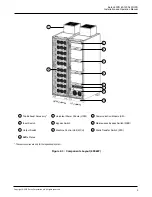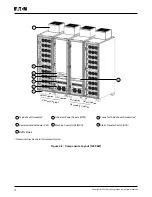
Eaton 93PR 60-1200 kW UPS
Installation and Operation Manual
21
Copyright © 2021 Eaton Corporation plc. All rights reserved.
The static bypass is comprised of a solid-state, silicon-controlled rectifier (SCR) static switch
(SSW) and a backfeed protection isolation device K5. The static switch is rated as a continuous-
duty device that is used anytime the inverter is unable to support the applied load. The static
switch is wired in series with the backfeed protection. The static switch, being an electronically-
controlled device, can be turned on immediately to pick up the load from the inverter without
interruption. The backfeed protection is normally always closed, ready to support the static switch
unless the bypass input source becomes unavailable.
2.3. UPS Features
The Eaton UPS has many features that provide cost-effective and consistently reliable power protection.
The feature descriptions provide a brief overview of the UPS standard features.
2.3.1. Advanced Battery Management
Advanced Battery Management technology uses sophisticated sensing circuitry and a
three-stage charging technique that extends the useful service life of UPS batteries while
optimizing the battery recharge time. ABM also protects batteries from damage caused by high
current charging and inverter ripple currents. Charging at high currents can overheat and damage
batteries.
In charge mode, the batteries are recharged. Charging lasts only as long as it takes to bring the
battery system up to a predetermined float level. Once this level is reached, the UPS battery
charger enters float stage and the charger is operating in constant voltage mode.
Rest mode begins at the end of charge mode; that is, after 48 hours of float charging (customer
adjustable). In Rest mode, the battery charger is completely turned off. The battery system
receives no charge current during this rest period of about 28 days (customer adjustable). During
Rest mode, the open circuit battery voltage is monitored constantly, and battery charging is
resumed when necessary.
2.3.2. Hot Sync
Hot Sync technology is an algorithm that eliminates the single point of failure in a parallel system
and therefore enhances the system reliability. The Hot Sync technology is incorporated in all
93PR UPSs, and it is utilised in both multi-module internal parallel and external parallel systems.
Hot Sync technology enables all uninterruptible power modules (UPMs) to operate independently
in a parallel system, even without inter-module communications. The power modules utilising
the Hot Sync technology are completely autonomous; each module monitors their own output
independently, to remain in complete synchronization with the other modules. The UPM power
modules share the load perfectly even in changing capacity or changing load conditions.
Hot Sync technology combines digital signal processing and an advanced control algorithm to
provide automatic load sharing and selective tripping in a parallel UPS system. The load share
control algorithms maintain synchronization and load balance by constantly making minute
adjustments to variations in the output power requirements. The modules conform to demand and
are not in conflict with each other for the load. Hot Sync systems are capable of paralleling for
both redundancy and capacity.
Summary of Contents for 93PR Series
Page 1: ...60 1200 kW Installation and Operation Manual Eaton 93PR UPS ...
Page 2: ......
Page 142: ......
Page 143: ...614 40061 01 ...
















































